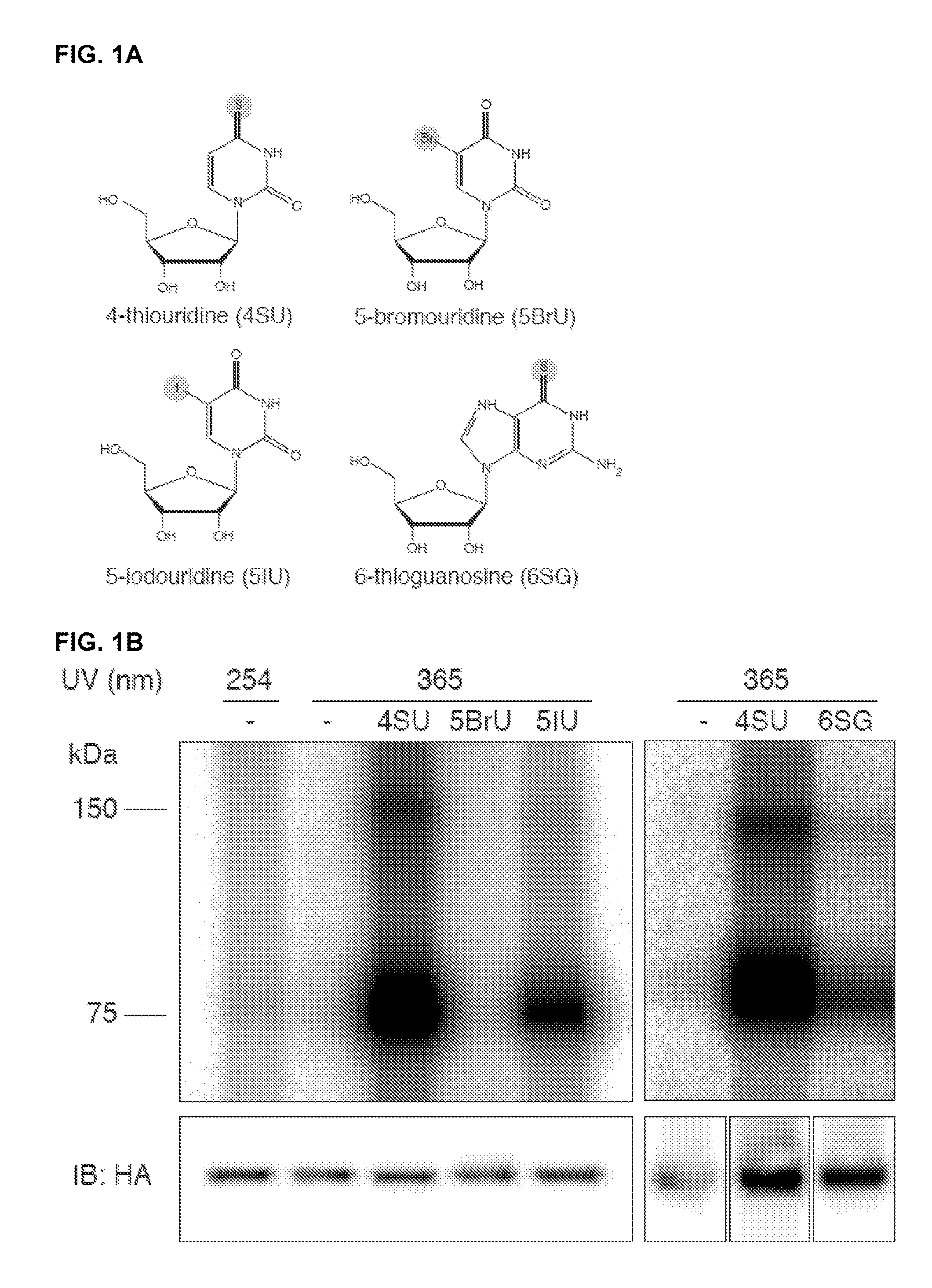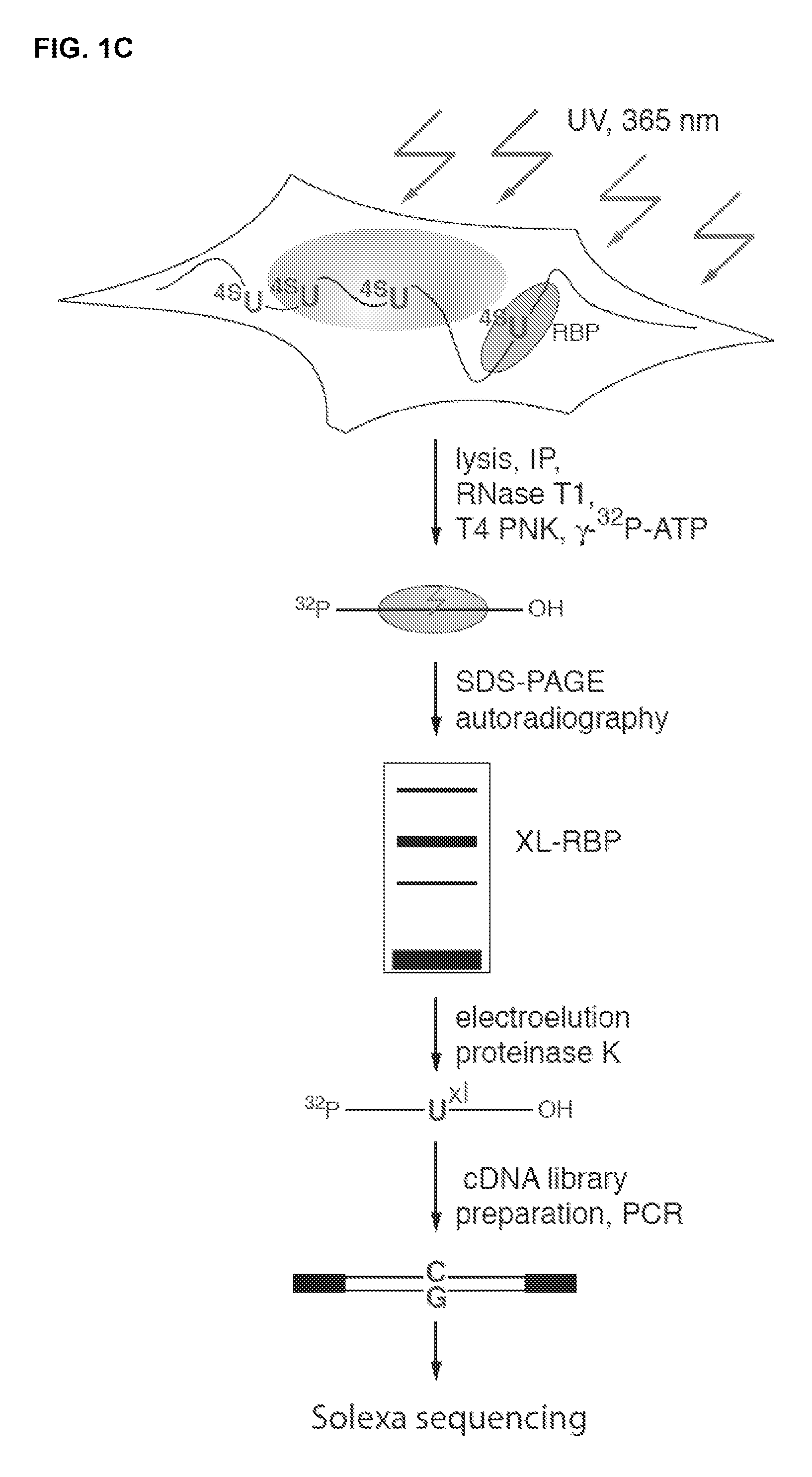Methods for Identifying RNA Segments Bound by RNA-Binding Proteins or Ribonucleoprotein Complexes
a technology of ribonucleoprotein complexes and rna segments, which is applied in the field of methods for identifying rna segments bound by rna-binding proteins or ribonucleoprotein complexes, can solve the problems of difficult identification of disease states such as autoimmune and genetic diseases, and few methods available to independently assess each process en mass
- Summary
- Abstract
- Description
- Claims
- Application Information
AI Technical Summary
Problems solved by technology
Method used
Image
Examples
example 1
Oligonucleotides
[0122]The following oligodeoxynucleotides were used for PCR and cloning of the listed genes (restriction site are underlined);
Pum2:(SEQ ID NO: 7)5′-ATGAATCATGATTTTCAAGCTCTTGCATTAG,(SEQ ID NO: 8)ATAAGAATGCGGCCGCTTACAGCATTCCATTTGGTGGTCCTCCAATAG;QKI:(SEQ ID NO: 9)ACGCGTCGACATGGTCGGGGAAATGGAAACG,(SEQ ID NO: 10)ATAAGAATGCGGCCGCTTAGCCTTTCGTTGGGAAAGCC;IGF2BP1:(SEQ ID NO: 11)ACGCGTCGACATGAACAAGCTTTACATCGGCAACCTC,(SEQ ID NO: 12)ATAAGAATGCGGCCGCTCACTTCCTCCGTGCCTGGGCCTG;IGF2BP2:(SEQ ID NO: 13)ACGCGTCGACATGATGAACAAGCTTTACATCGGGAAC,(SEQ ID NO: 14)ATAAGAATGCGGCCGCTCACTTGCTGCGCTGTGAGGCGAC;IGF2BP3:(SEQ ID NO: 15)ACGCGTCGACATGAACAAACTGTATATCGGAAACCTCAG,(SEQ ID NO: 16)ATAAGAATGCGGCCGCTTACTTCCGTCTTGACTGAGGTGGTC;
Plasmids
[0123]Plasmids pENTR4 IGF2BP1,-2,-3, QKI, and PUM2 were generated by PCR amplification of respective coding sequences (CDS) followed by restriction digest and ligation into pENTR4 (Invitrogen). Primer sequences are listed under DNA oligonucleotides in Suppl. Material. pE...
example 2
PURE-CLIP
[0135]Human embryonic kidney (HEK) 293 cells stably expressing FLAG / HA-tagged IGF2BP1-3, QKI, and PUM2 (Landthaler et al., 2008, incorporated herein by reference in its entirety) were grown overnight in medium supplemented with 100 μM 4-thiouridine (4SU). Living cells were irradiated with 365 nm UV light (0.15 J / cm2) n a Stratalinker 2400 (Stratagene). Cells were harvested and lysed in 3 cell pellet volumes of NP40 lysis buffer (50 mM HEPES-KOH, pH 7.5, 150 mM KCl, 2 mM EDTA, 1 mM NaF, 0.5% (v / v) NP40, 0.5 mM DTT, complete EDTA-free protease inhibitor cocktail (Roche)). The cell lysate was cleared by centrification at 13,000×g.
[0136]RNase T1 (Fermentas) was added to the cleared cell lysates to a final concentration of 1 U / μl and the reaction mixture was incubated at 22° C. for 15 min and subsequently cooled on ice before addition of antibody-conjugated magnetic beads. FLAG / HA-tagged AGO proteins were immunoprecipitated with anti-FLAG antibodies bound to Protein G Dynabeads....
example 3
Application of Photoreactive Nucleosides to Cultured Cells Enhances UV Crosslinking Between RNA and RBP
[0140]Incorporation of modified photoreactive nucleoside analogues into RNA facilitates UV crosslinking to RBPs (Meisenheimer and Koch, 1997), as shown previously for in vitro transcribed site-specifically labeled RNAs (Kirino and Mourelatos, 2008; Moore and Query, 1998). Several of these photoreactive nucleosides are excitable by longer wavelength UV (>300 nm) and are readily taken up by cells, where they are incorporated into nascent transcripts without noticeable toxicity and then can be used for in vivo crosslinking (Bezerra and Favre, 1990; Favre et al., 1986; Wagenmakers et al., 1980). We applied a subset of these nucleoside analogues (FIG. 1A) to cultured cells expressing the FLAG / HA-tagged RBP IGF2BP1. Live cells were UV-irradiated at 365 nm. The crosslinked RNA-protein complexes were isolated by immunoprecipitation, and the covalently bound RNA was partially digested with ...
PUM
 Login to View More
Login to View More Abstract
Description
Claims
Application Information
 Login to View More
Login to View More - R&D
- Intellectual Property
- Life Sciences
- Materials
- Tech Scout
- Unparalleled Data Quality
- Higher Quality Content
- 60% Fewer Hallucinations
Browse by: Latest US Patents, China's latest patents, Technical Efficacy Thesaurus, Application Domain, Technology Topic, Popular Technical Reports.
© 2025 PatSnap. All rights reserved.Legal|Privacy policy|Modern Slavery Act Transparency Statement|Sitemap|About US| Contact US: help@patsnap.com



